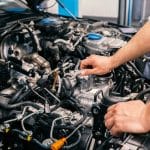Regular dock lift maintenance will protect your investment, ensure safety, and extend the lifespan of your equipment. Neglecting proper care can lead to unnecessary repairs, safety risks, and costly replacements. This guide will walk you through essential dock lift maintenance tips to keep your equipment in top condition.
Conduct Regular Inspections
Routine inspections form the foundation of maintaining your dock lift. Begin by visually inspecting the platform and support beams for structural damage, such as cracks, wear, or rust. Loose bolts or misaligned parts can cause issues, so tighten any that appear to have loosened over time.
Always inspect the cables and pulleys for signs of fraying or damage. A thorough inspection identifies small issues before they escalate into larger and more expensive problems.
Lubrication Best practices
Consistent lubrication ensures your dock lift operates smoothly and prevents premature wear on moving parts. Use manufacturer-recommended lubricants and apply them to all moving components, including hinges, cables, and pulleys.
Over-lubrication can attract dust and debris, so apply only enough to coat the parts lightly. Schedule lubrication monthly or more frequently if your dock lift operates in a high-use environment.
Hydraulic System Care
The hydraulic system is the heart of your dock lift. One of the most important tasks is checking the hydraulic fluid levels on a regular basis. Low fluid levels can result in erratic movement or a complete malfunction. Use clean hydraulic fluid and inspect for contaminants such as dirt or water.
Inspect hydraulic hoses for leaks or cracks, as even small issues can affect performance. Promptly repair and replace damaged components to maintain system reliability.
Maintaining Electrical Components
Electrical components power your dock lift and require special attention. Inspect wires and connections for signs of wear or corrosion. Replace frayed wiring and clean corroded connectors promptly. Test all buttons, controls, and emergency stops to verify they function correctly. If your dock lift begins to display erratic movement or unresponsive controls, consult a professional to resolve electrical issues effectively.
Safety Measures
Safety plays a key role in dock lift maintenance. Check that all safety guards and restraints are in place and functioning correctly. Test the lift’s emergency stop feature and verify that the weight capacity indicators are legible.
Do not overload the dock lift, as this can strain its components and reduce its lifespan. Train all users on proper operation to minimize human errors that might damage the equipment.
Handle Dock Lift Problems
Common problems like unusual noises, jerky movements, or slow operation often indicate underlying issues. Address these right away to avoid mechanical failures. Unusual noises may point to a lubrication issue, while jerky movements could signal hydraulic problems. Diagnosing and fixing these problems early will help you avoid the need to repair or replace the lift down the road.
Seasonal Maintenance Matters
Seasonal changes can impact your dock lift’s performance. During winter, protect it from freezing temperatures by covering it and draining the hydraulic fluid if it will not be in use for extended periods.
Summer heat, on the other hand, can lead to hydraulic fluid consistency issues. Adjust your maintenance schedule based on the seasons for optimal performance throughout the year.
Consistent dock lift maintenance leads to better performance, fewer repairs, and a longer lifespan for your equipment. When properly maintained, your lift remains safe and reliable for years to come. If your dock lift begins to show signs of heavy wear despite your best efforts, transitioning to buying a new boat lift may become a worthwhile consideration. Regular care gives you the confidence to make the right decision at the right time without unnecessary pressure. Keep your dock lift in optimal condition with these best practices.







